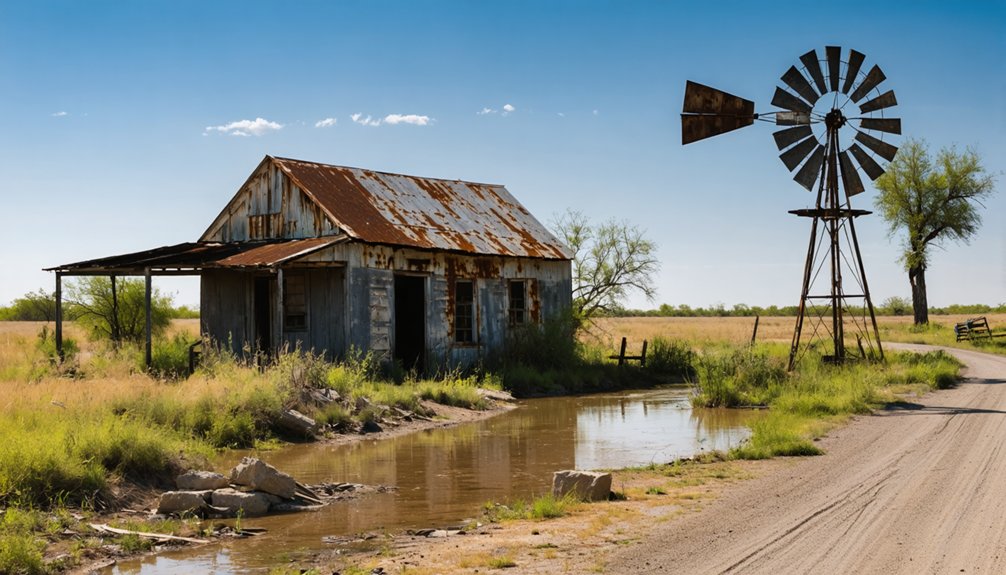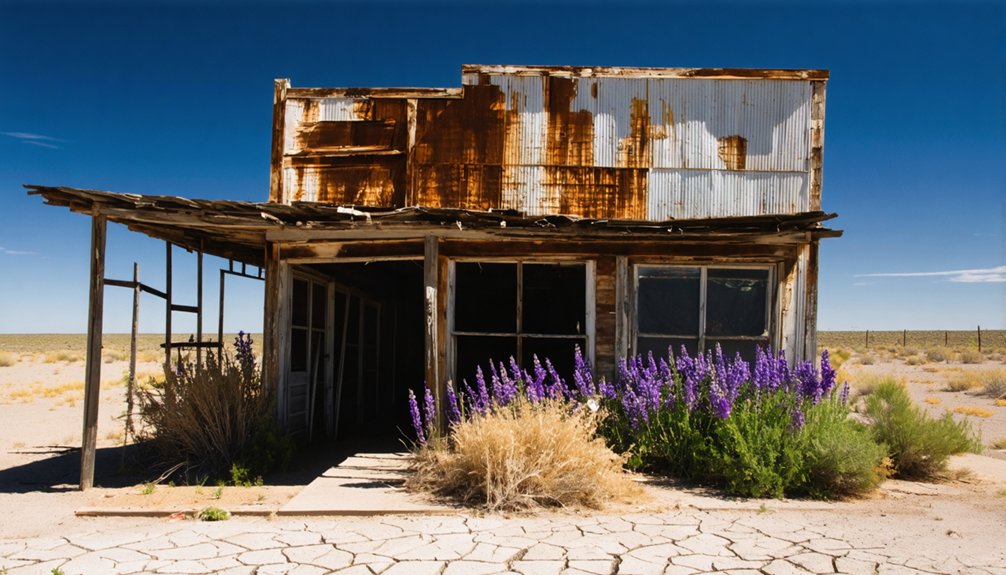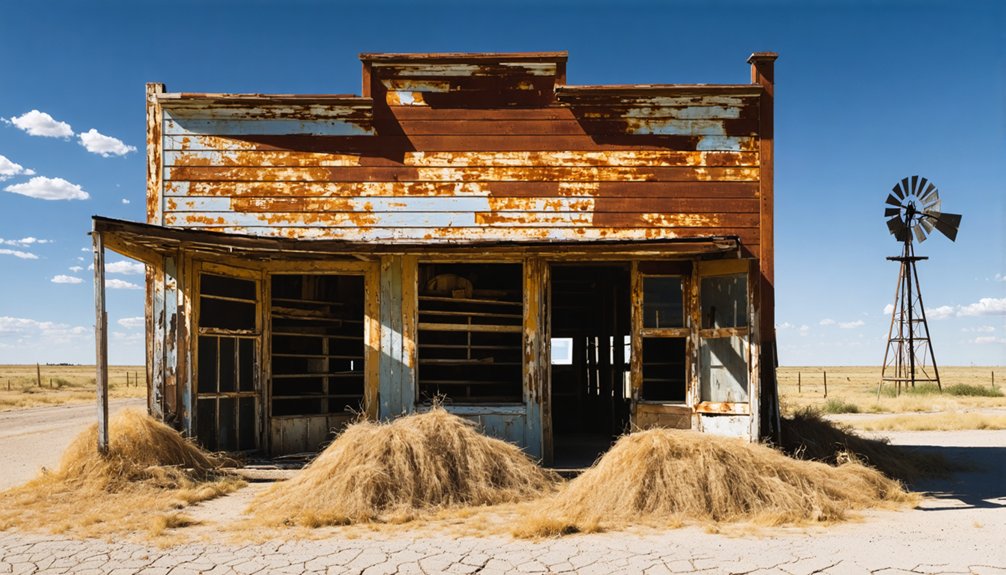You’ll find Sanco’s ghost town remnants in Coke County, Texas, where Chief Sanaco’s Comanche territory once thrived. The settlement began in the 1870s when ranchers like J.J. Austin established headquarters near Yellow Wolf Creek. J.L. Durham opened the first post office in 1888, marking Sanco’s growth into a proper community. While the town relocated in 1907 due to water issues, its abandoned structures now tell tales of frontier life and pioneer resilience.
Key Takeaways
- Sanco was established in 1888 with its first post office, named after Comanche Chief Sanaco who previously controlled the territory.
- The community relocated in 1907 due to inadequate water access, with original structures now standing abandoned as tourist attractions.
- Early settlement consisted of scattered ranch homes near Yellow Wolf Creek, supporting cattle and sheep operations.
- Abandoned 19th-century buildings attract heritage tourism visitors interested in exploring Texas ghost town history.
- The site features historical structures, a cemetery, and interpretive displays detailing the town’s economic and social development.
The Legacy of Chief Sanaco
Leadership and territorial dominance defined Chief Sanaco’s enduring legacy in Central Texas.
You’ll find his influence most prominently in the Penatuhkah Comanche territory near the San Saba and Colorado Rivers, where he commanded a formidable band that united with chiefs Yellow Wolf and Buffalo Hump, amassing around 10,000 followers.
The Comanche influence under Sanaco’s leadership wasn’t just about numbers – it’s etched into the very landscape. His strategic camp near Spring Creek became the foundation for what you now know as Sanco, Texas. Yellow Wolf’s grave nearby serves as another testament to the area’s rich Native American heritage.
Following the death of his father Chief Muguara in 1840, Sanaco emerged as a fierce and uncompromising leader in protecting Comanche interests.
His legacy lives on through the region’s place names, burial grounds, and historical markers. Even during the turbulent pre-Civil War era, Sanaco’s diplomatic engagements with Texas officials like Robert Simpson Neighbors showcase his role in shaping Native American-settler relations during this pivotal period.
Early Settlement and Ranching Days
You’ll find the earliest community roots in Sanco traced to ranchers drawn by open grazing lands in the 1880s, with J. L. Durham establishing the first post office from his home in 1888.
The settlement’s initial infrastructure centered around scattered ranch homes and farms rather than a concentrated town layout, with J. J. Austin’s ranch headquarters near Sanco serving as an early anchor point from 1875.
The original settlement site, located about a mile east of the town’s later position, included both ranching operations and a primitive church that would eventually prompt the town’s relocation. Evidence of earlier habitation exists in the area, with a prehistoric Native American camp discovered at the site. The land had particular significance as it was once the territory of Chief Sanaco’s tribe, from whom the town would later derive its name.
Ranchers Establish First Community
After Chief Sanaco’s Comanche tribe used the area as their nomadic base in the early 1800s, permanent settlement began with pioneering ranchers in the 1870s.
You’ll find that J.J. Austin established the first ranch headquarters in 1875, followed by Pate Francher in 1877, marking the start of ranching culture in the region.
The early community thrived on open grazing lands with minimal infrastructure.
You won’t find evidence of stores, churches, or formal buildings during this period – just scattered ranch headquarters near Yellow Wolf Creek.
Community development centered around practical needs, with ranch homes serving as makeshift gathering spots.
The settlers chose this location because Yellow Wolf Creek provided a reliable water source for their livestock and farming needs.
The area remained largely undeveloped until Coke County’s establishment in 1889.
Durham’s Post Office Opens
The establishment of Sanco’s first post office on July 10, 1888, marked a pivotal moment in the community’s development. You’ll find that J. L. Durham, serving as postmaster, operated this essential communication hub from his own home, taking on responsibilities that went far beyond sorting mail. While mail delivery was crucial for pioneers, postage-due letters were common, with recipients covering the mailing costs.
Durham’s post office quickly became the heart of Sanco’s social fabric. As one of the area’s first formal institutions, it wasn’t just a place to send and receive letters – it served as a gathering spot where you’d find neighbors catching up on news, conducting business, and even holding worship services. This pattern of post offices serving as community centers was common in mining towns like Durham coal town, which established its own post office in 1892.
Durham himself suggested the town’s name, believed to be inspired by a Comanche chief’s name, though slightly misspelled. This central fixture helped transform Sanco from a scattered settlement into a more cohesive community.
Church Spurs Town Relocation
While Sanco’s original settlement served ranching families well in the 1880s, inadequate water access and rough terrain ultimately sparked the community’s relocation in 1907.
Before the move, you’d find worship services held in makeshift spaces, as homes doubled as gathering places for the scattered ranching families.
The relocation to flatter, water-rich land marked a significant shift toward community continuity, enabling agricultural adaptation beyond traditional ranching.
You’ll notice this transformation reflected in the construction of Sanco’s first Methodist church at the new site, symbolizing the town’s commitment to permanence.
The move supported diversification into cotton farming, though these efforts eventually succumbed to drought, pests, and market pressures, leading the community back to its ranching roots.
Like other areas in Coke County, the community faced devastating losses when boll weevil infestations decimated cotton crops in the 1920s.
The Heart of Coke County
You’ll find Sanco nestled in central Coke County along Yellow Wolf Creek, where early ranchers established homesteads during the 1880s amid the region’s shift from open range to fenced grazing lands.
The town’s location near what would become Texas State Highway 208 and Farm to Market Road 18 connected it to larger settlements like Robert Lee and Colorado City, facilitating the movement of cattle and supplies. Much like how Mie Kotsu Co. evolved from railways to buses, Sanco adapted to changing transportation needs over time.
The natural landscape, marked by creek-fed grasslands suitable for cattle grazing, attracted pioneering ranchers like L.B. Harris, who owned twelve sections of prime riverfront property in the surrounding area.
Early Ranching Settlement History
From its earliest days as Comanche hunting grounds in the 1700s to its transformation into a thriving ranching community by the late 1800s, Sanco’s history mirrors the dramatic evolution of Coke County’s frontier settlement.
You’ll find the area’s ranching techniques evolved rapidly after J.J. Austin established his headquarters near Sanco in 1875. Settlement challenges emerged as newcomers like Pate Francher arrived in 1877, driving cattle for Austin and McConnel.
The introduction of barbed wire fencing sparked conflicts between established ranchers and landless cattlemen, while severe drought in the 1880s intensified disputes over water rights.
Natural Landscape Features
As rugged terrain stretches across Sanco’s landscape, you’ll encounter diverse geological features ranging from open prairies to rolling hills, with elevations varying between 1,800 and 2,600 feet throughout Coke County. Notable geological landmarks include the distinctive Cement Mountain and Cemetery Draw, which punctuate the horizon against a backdrop of sandy loam and red soils.
You’ll find crucial water sources cutting through the land, with the Colorado River and Yellow Wolf Creek sustaining the region’s ecosystem. These waterways, receiving about 20 inches of annual rainfall, support the area’s rich biodiversity.
The natural landscape creates perfect conditions for native grasses like mesquite, needlegrass, and sideoats, while the creek valleys provide essential corridors for wildlife movement and agricultural development.
Transportation Network Evolution
The transportation network of Coke County underwent dramatic evolution following the establishment of Fort Chadbourne in 1851, which served as a pivotal waypoint for early travel routes.
You’d find the Butterfield Overland Mail stagecoach connecting settlements across 2,700 miles until 1861, including stops near Sanco.
The region’s infrastructure development transformed dramatically when the Texas and Pacific Railway reached San Angelo in 1882.
You’ll notice how this railway connection sparked settlement growth and changed how ranchers moved their cattle to market.
By 1942, Farm to Market Road 18 cut through Sanco, while Texas State Highway 208 connected the area’s scattered communities.
These transportation routes adapted to serve the region’s evolving needs, from horse-drawn wagons to automobiles, reflecting the changing demands of agriculture and commerce.
Rise and Fall of Cotton Production
Cotton cultivation took root in Texas when Spanish missionaries first introduced the crop in the early 18th century, with mission craftsmen spinning and weaving the harvested fibers.
You’ll find that cotton economics rapidly evolved as Anglo-American colonists expanded production, especially in Stephen F. Austin’s colonies near San Felipe de Austin in the 1820s. By 1849, Texas produced over 58,000 bales, climbing to an impressive 431,645 bales by 1859.
In Sanco’s region, cotton farming flourished as railroads replaced river transport routes. You could see the agricultural landscape transform as production peaked around 1900, with Texas fields yielding more than 3.5 million bales across 7 million acres.
However, the agricultural decline hit hard when the devastating boll weevil infestation swept through in the 1920s, severely damaging local crops.
Life Around Yellow Wolf Creek

While Comanche Chief Sanaco and Chief Yellow Wolf originally claimed the area as their tribal camping grounds, pioneering settlers began establishing dugout homes near Yellow Wolf Creek in the late 1800s.
You’d find these early homesteaders using the creek’s crucial water supply for their cattle and sheep operations, marking the area’s shift from Native American territory to frontier settlement.
The community dynamics evolved rapidly after 1887, when you’d see the first cemetery, Methodist church, school, and essential businesses take root.
Though the Civil War temporarily disrupted settlement patterns, by 1907, the town had relocated closer to Yellow Wolf Creek, where the cultural heritage of both settlers and Native Americans intertwined.
The creek’s name itself commemorates Chief Yellow Wolf, who was killed in battle with Lipan Apaches and buried nearby.
Architectural Remnants and Lost Structures
Along Yellow Wolf Creek in Central Coke County, Sanco’s architectural legacy began in the 1880s when pioneering ranchers constructed buildings using locally quarried sandstone and limestone.
You’ll find the most prominent architectural decay in the 1860s church ruins, where Gothic-style arches and diamond-shaped windows still hint at its medieval European inspiration despite fire damage from 1910. The community memory lives on through remaining hand-tooled stonework, displaying skilled craftsmanship in the weathered walls.
Until 2020, you could’ve visited the town center’s cafe, guest rooms, and apartments, but a mysterious fire claimed these final vestiges of civilization.
Today, only the headless robot sculpture made from oil field weights stands sentinel near the abandoned church ruins, while nature steadily reclaims this once-thriving settlement.
Education Through the Ages

Beyond the crumbling walls and vacant structures, Sanco’s educational heritage reveals a story of rural Texas schooling from the 1880s onward.
You’ll find that the town’s educational evolution centered around a main schoolhouse that served students from neighboring communities like Horse Mountain and Meadow Mountain. During Sanco’s cotton boom, the school system thrived through strong community engagement, with the buildings serving as both learning centers and social hubs.
As you explore deeper, you’ll discover how the boll weevil infestation and severe drought triggered a chain reaction. These environmental challenges crippled the cotton economy, forcing families to relocate and ultimately leading to the school’s decline.
Today, the vandalized remnants of the school building stand as silent witnesses to Sanco’s once-vibrant educational past.
The Slow Fade of a Texas Community
Through a series of economic blows in the 1920s, Sanco’s transformation into a ghost town began with the devastating combination of boll weevil infestation and severe drought.
Despite initial community resilience, the lack of a railroad connection and limited economic diversification left the town vulnerable to decline.
You’ll find the story of Sanco’s fade marked by distinct economic changes. The town maintained its core services until the 1970s, when its post office, school, store, and blacksmith shop shuttered almost simultaneously.
Without major employment opportunities, residents steadily departed. The once-vibrant ranching and agricultural hub couldn’t sustain itself, and by the late 20th century, the town stood empty.
Today, only deteriorating buildings remain, with the church and cemetery serving as silent witnesses to Sanco’s vanished community.
Ghost Town Tourism and Historical Value

While Sanco’s population has dwindled to zero, its abandoned structures and rich history now attract visitors seeking authentic glimpses into Texas’s past.
Through ghost town preservation efforts, you’ll find opportunities to explore 19th-century architectural remnants and learn about early settlement patterns in the region.
Historic ghost towns reveal stories through preserved buildings, offering a window into the settlement patterns of Texas’s pioneering past.
Tourism impact extends beyond mere sightseeing – it generates essential revenue through guided tours and helps fund the maintenance of historical structures.
You’ll discover interpretive displays that detail the town’s economic and social life, contributing to broader heritage awareness.
As you explore, you’re participating in a growing heritage tourism market that’s projected to expand considerably by 2030.
However, it’s important to approach these historic sites respectfully, as increased visitation can pose challenges to preservation efforts and the surrounding environment.
Frequently Asked Questions
Are There Any Descendants of the Original Sanco Settlers Still Living Nearby?
You’d need to text a genealogist, as descendant stories and family histories aren’t officially documented. While some modern residents might have ancestral ties, there’s no clear evidence linking current locals to original settlers.
What Wildlife Can Commonly Be Found Around the Abandoned Town Today?
You’ll spot white-tailed deer, coyotes, and hawks in the restored grasslands. Wildlife sightings include roadrunners, rattlesnakes, and tarantulas, while local ecology supports diverse populations of quail and rabbits.
Has Sanco Ever Been Featured in Movies or Television Shows?
You won’t find Sanco in any major films or television shows. While amateur ghost hunters have posted YouTube videos exploring the town, there aren’t any professional Sanco documentaries or productions.
Were There Any Notable Crimes or Mysteries Associated With Sanco?
You won’t find any documented unsolved murders or ghost sightings in the historical records. Research shows the town’s decline was due to economic hardships rather than mysterious or criminal events.
Do Any Annual Events or Gatherings Still Take Place in Sanco?
You won’t find any annual celebrations or community gatherings taking place in Sanco today. The ghost town’s abandoned state means it’s no longer an active venue for organized events.
References
- https://www.youtube.com/watch?v=mn21CXush1M
- https://texashistory.unt.edu/explore/partners/PCDL/
- https://en.wikipedia.org/wiki/Sanco
- https://en.wikipedia.org/wiki/List_of_ghost_towns_in_Texas
- https://www.reporternews.com/story/news/columnists/big-country-journal/2018/10/28/big-country-journal-coke-county-ghost-town-sanco-has-its-own-robot/1797419002/
- https://www.tshaonline.org/handbook/entries/sanco-tx
- https://www.texasescapes.com/TexasTowns/Sanco-Texas.htm
- https://www.brownwoodnews.com/2024/09/26/diane-adams-remembering-chief-sanaco/
- http://files.usgwarchives.net/tx/coke/cemetery/sancocem.txt
- https://www.hmdb.org/m.asp?m=82994



